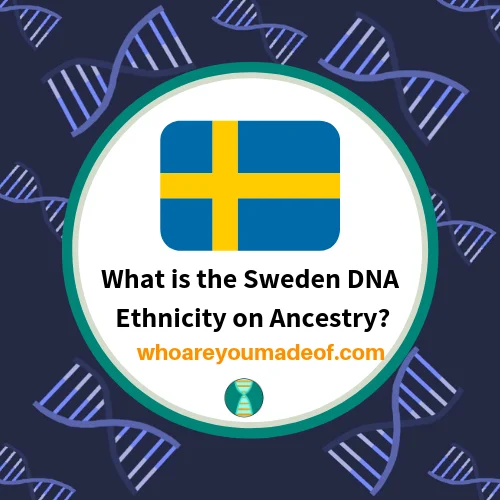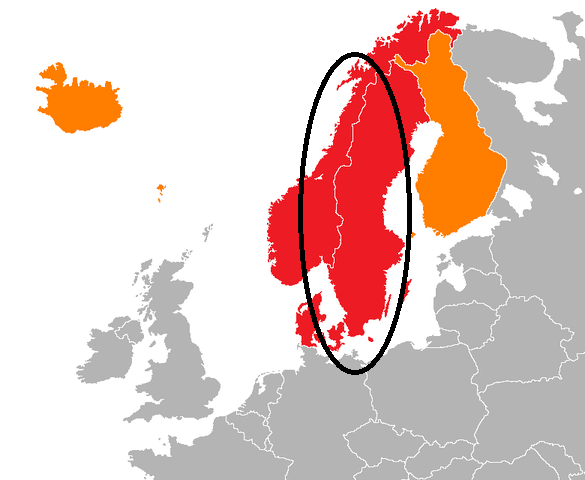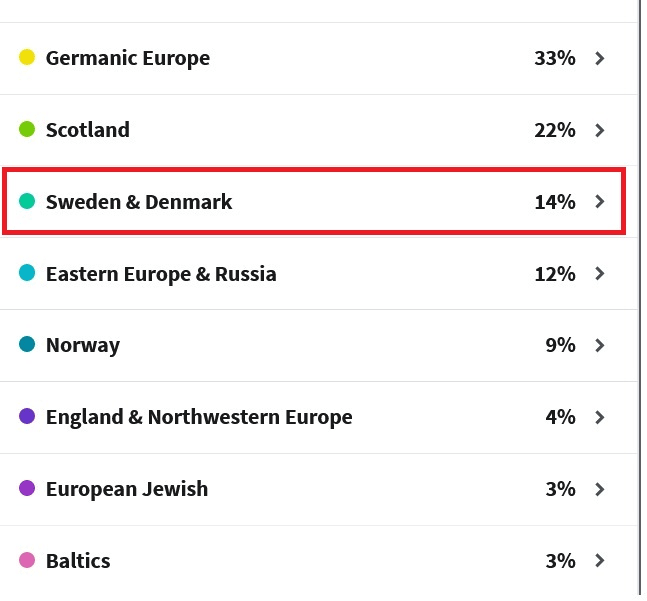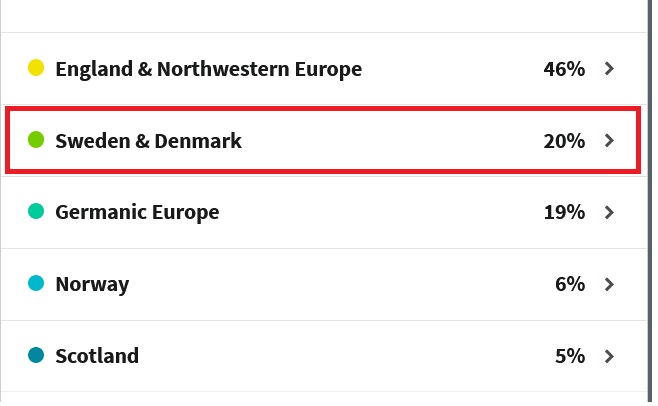Did you get the Sweden DNA region on Ancestry? More than 4.5 million people in Canada and the United States have known Swedish roots, and even more have Swedish ancestry that they are just beginning to discover.
In this post, I'll discuss the most common questions related to the Swedish DNA region on Ancestry.

Where is the Sweden and Denmark DNA Ethnicity on Ancestry located?
Naturally, Swedish and Danish DNA is most commonly found in Sweden and Denmark. However, it is important to note that you can also find substantial percentages of Swedish and Danish DNA outside the modern-day geographic boundaries of these countries.
According to Ancestry, people who live in Denmark are also very likely to have the Sweden DNA region in their ethnicity estimate. The Ancestry DNA update that occurred in September 2021 combined Denmark with the Sweden DNA region, making a new Sweden and Denmark ethnicity region.
The image below shows the approximate region (within the black circle) where people having DNA matching the Sweden and Denmark region is most commonly found.

Image credit: By 000peter - Own work, CC BY-SA 3.0
Why is there Sweden DNA in other parts of Europe?
Sweden began to rise in international power and influence during the 1600s. This period of Swedish power lasted for hundreds of years with Sweden in direct control of much of the Baltic region.
Modern-day countries that at one time fell within the realm of Swedish rule include all of Sweden, Finland, Latvia, Estonia, and parts of Poland, Lithuania and Germany.
The age of the Swedish dominance of Northern Europe ended officially with the loss of Finland to the Russians in 1809, and definitively with the dissolution of the United Kingdoms of Sweden and Norway in 1905. Even so, Swedish DNA lives on in those of us who are descended from people who lived in those places once ruled by Sweden, including Denmark.
Swedish DNA, trade, and the Vikings
If you don't have ancestors from any of the countries that used to be dominated by Sweden during its age of Northern European dominance, it's good to keep in mind that economic strength grew along with political power (think: trade, ships, merchants).
Once Swedish dominance began to wane, Swedes began to migrate to other countries in greater numbers, and there has almost always been Swedish migration to the UK.
Finally, while Viking raids happened long, long ago, it's still possible (and probable) that many people still carry a genetic trace of these Nordic ancestors.
Did you know? Have you heard about the Swedish colony in what is now the United States? Yes, seriously! Sweden once considered parts of modern-day Delaware, Pennsylvania, and New Jersey part of "New Sweden".
How far back in your family tree are your Swedish or Danish ancestors?
You might wonder if there is some way that you can calculate how far back your Swedish ancestor is based on the percentage of Swedish DNA that shows up in your ethnicity estimate.
It's not possible to know for sure based only on the percentage of the Sweden DNA region that shows up for you, but I will give you a rule of thumb that can help you estimate how far back it might be.
The basic "rule of thumb" for trying to figure out how far back your "100% Swedish" is assumes (for simplicity) that the percentage of the ethnicity will double every generation. For example, if you have 50%, then the assumption is that one of your parents had 100%.
In reality, ethnicity isn't passed down in beautiful 50% increments (what would be the fun!?), and so we usually have to work a bit harder - especially with a "surprise" ethnicity region - to figure out where our ancestry came from.
Take, for example, my own ethnicity estimate. In the image below, you can see that I have 14% Sweden and Denmark DNA on Ancestry. If the rule of thumb applies to me, then we would expect one of my parents to have 28% Swedish or Danish DNA.

I was lucky and my dad agreed to do the Ancestry test, and I can see that the rule of thumb isn't going to work for me. He has 20% Swedish DNA!

In other words, I didn't inherit 50% of my dad's Swedish DNA. Additionally, I don't know if he inherited his DNA matching this region from his mother and his father.
After a bit more research, I realized that my mother also shows DNA matching this region - 14%, to be exact. This means that I likely have inherited some DNA matching the Sweden and Denmark ethnicity region from both of my parents.
The percentage of DNA that we inherit from any of our parents' DNA ethnicity regions is completely random. We could get half of it, less than half, or more than half (or even all of it!).
True, we inherit 50% of our mother's DNA and 50% of our father's DNA, but there is no way to predict which 50% of their DNA will get passed down to us.
Pro tip: Have as many people in your family as possible take DNA tests. Your siblings will have inherited a different selection of DNA from your parents than you did.
Your parents will have DNA for regions that they didn't pass down to you. Are your grandparents willing to test? They are an amazing resource since they have DNA that they didn't pass to your parents.
Is it possible to trace your Swedish DNA?
If you are interested in tracing your Swedish or Danish ancestry based on your DNA results, you are in luck. If you start at number one (that's you!) and work back carefully, you have a good chance at being able to learn information about your Swedish ancestors.
Building your family tree is the best way to find the ancestor who gave you your Sweden and Denmark DNA
What do I mean by "working back" and what's the best way to do it? In order to learn as much as you can about your ancestry, the best place to start is building a family tree.
It's fun (really!) and not nearly as difficult as it was for genealogists in the past.
I build my family trees on Ancestry (read why I prefer Ancestry for building family trees). Since I have tested my DNA there, I can easily connect my tree to my DNA results and get access to extra features.
While it's free to build a family tree on Ancestry, it is easiest to do it with a subscription.
You can add records, photographs, dates, and names very quickly this way, and it saves a lot of time.
If you think you would like to try a free trial on Ancestry to see how you like it, you can use the following link to get a two-week free trial. If you subscribe at the end of your trial, I may get a small commission at no extra cost to you that helps me support the work I do on this website (much appreciated!!): Ancestry Free Trial
Conclusion
I hope that this post helped you understand more about your Swedish and Danish DNA, how you may have inherited it, and how far back you might have to look in your family tree to find your Swedish ancestors.
If you have any questions about something that you read in this post or if you would like to share your own experience finding Swedish DNA in your Ancestry results, I'd love to hear from you in the discussion below.
Thanks for being here today!


Stacey
Wednesday 27th of September 2023
I was very surprised with my results I have 45 % Sweden Denmark. I didn’t even know I had any.
Richard Hellstrom
Saturday 25th of February 2023
When they first started noting Swedish DNA separately, they noted me at 4 percent. I have recently done a YDNA test at 67 markers, and I have a predicted Haplogroup of a G-M201. I used the G2a Subclade tool, and it noted that I had the G-L497 subclade. https://discover.familytreedna.com/y-dna/G-M201/story http://www.hprg.com/hapest5/ I have people from Finland, Sweden, England and America in my matches. My family traces back to Sweden to the 1600's and earlier and the first family member we had in America was my grandfather who married a Swede. My father shows 8 percent English autosomal DNA in his side view technology data at Ancestry. His mother was German and Dutch to the best of my guess. I don't currently show any German or Dutch DNA. I don't think she would have had any English DNA though but who knows. I guess I could be part Danish, but it would be nice to be able to detail or separate those variables. Maybe we need some kind of Y DNA oracle. The moderators at the G-L497 forum assume I will fit in somewhere in the Z39674 Haplogroup but have noted that I need to take the Big Y 700 marker test to make a final determination. My current notation at Ancestry denotes me at 16 percent Swedish/Denmark. I have no idea, but those percentages could be a lot of separate variables. Out of 442 Ancient Viking Skeletons- only two were from the G Haplogroup. https://discover.familytreedna.com/y-dna/G-Z39674/story Viking Skeletons https://dna-explained.com/2020/09/18/442-ancient-viking-skeletons-hold-dna-surprises-does-your-y-or-mitochondrial-dna-match-daily-updates-here/
Donna Owens
Sunday 5th of February 2023
Thank you for your article, I too have 14% Swedish & Danish DNA which looks like it is from my mum. We had no idea of this kind of DNA, I have managed to go back quite a way on my mums side with a tree and most of her family are originally from France and aristocracy so possibly the Danish could be from Vikings settling in France. I wouid love ti know more, not found any ancestors confirmed from those regions yet.
SHIRLEY EIBY(Ostwald)
Monday 2nd of January 2023
Thank you for such interesting commentary . I’m Australian and get my DNA results later this week . I am also building my family tree. I am female and my maternal DNA is Danish from her father )both his parents had Danish parents. My mum's mother was of strongly Swedish ( three generations but original English dye to the Jacobites). My father was strongly German on paternal side but Scottish/Irish on maternal side. So I’m very Nordic and looking forward to seeing the breakdown of my DNA. Any comments from you would be welcomed.
Corey
Tuesday 27th of September 2022
Thank you for your article. My great grandfather was from Denmark and I share some of his DNA. I've had such trouble finding any dna matches to this line that allow me to find out who his parents were etc. I have a tree on ancestry with my DNA attached. Any tips on navigating the Denmark heritage would be appreciated.